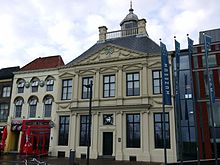Cornelius Lampsins
| Cornelius Lampsins | |
|---|---|
 Cornelis Lampsins, c. 1655 | |
| Baron of Tobago | |
| Reign | 1662–1664 |
| Predecessor | none |
| Successor | Adrian Lampsins (as sole baron) |
| Co-Baron | Adrian Lampsins |
| Governor | Hubert de Beveren |
| Born | 17 September 1600 Vlissingen, Dutch Republic |
| Died | 2 September 1664 Vlissingen, Dutch Republic |
| Spouse | Tanneken Geleyns Boers |
| Issue | Jan Lampsins |
Cornelius Lampsins (or van Lampsin, also Corneille Lampsius), was, along with his brother Adrian, the Baron of Tobago from 1662 to 1664.
Cornelius Lampsins was born in 1600 to a very wealthy Dutch merchant family, and he was involved in the early colonization of the Caribbean, in the 1630s. He owned a fleet of over three hundred trading vessels, and helped found the colonies of Martinique and Saint Thomas.

In 1654, the Lampsins brothers led a Dutch colonial expedition to Tobago, which was then New Courland. There was much dispute between the Couronian and Dutch colonists, and when Courland surrendered to Sweden in 1659, the Lampsins brothers took control of the colony.[1] In 1662, the brothers were elevated to Barons by the French King Louis XIV, and the Lampsins family reigned until the English invaded the island in 1666.[2][3]
Cornelius Lampsins had two sons, Jan and Geleyn who participated in running the settlement on Tobago with their uncle.[4] The descendants of the Lampsins brothers maintained many rights to the island until 1749.
See also
References
- ^ Arbell, Mordehay. “Jewish Settlement in Tobago.” The Jewish Nation of the Caribbean: the Spanish-Portuguese Jewish Settlements in the Caribbean and the Guianas, Gefen Pub., 2002, pp. 61–64.
- ^ Riddell (Author), Henri de Bourbon (comte de Chambord.), John. “The Patent of Baron to C Van Lampsins.” The Pedigree of the Duchess of Mantua, Montferrat and Ferrara, Oxford University, 1885, pp. 8–10.
- ^ Edwards, Bryan. The History Civil and Commercial, of the West Indies: with a Continuation to the Present Time. Cambridge University Press, 2010.
- ^ Charles De Rochefort (1665). Le tableau de l'isle de Tabago, ou de la Nouvelle Oüalchre, l'une des isles Antilles de l'Amérique, dependante de la souveraineté des hauts et puissants seigneurs les estats generaus des Provinces Unies des Pays-Bas. Chez Jean le Carpentier. pp. 66–72.
